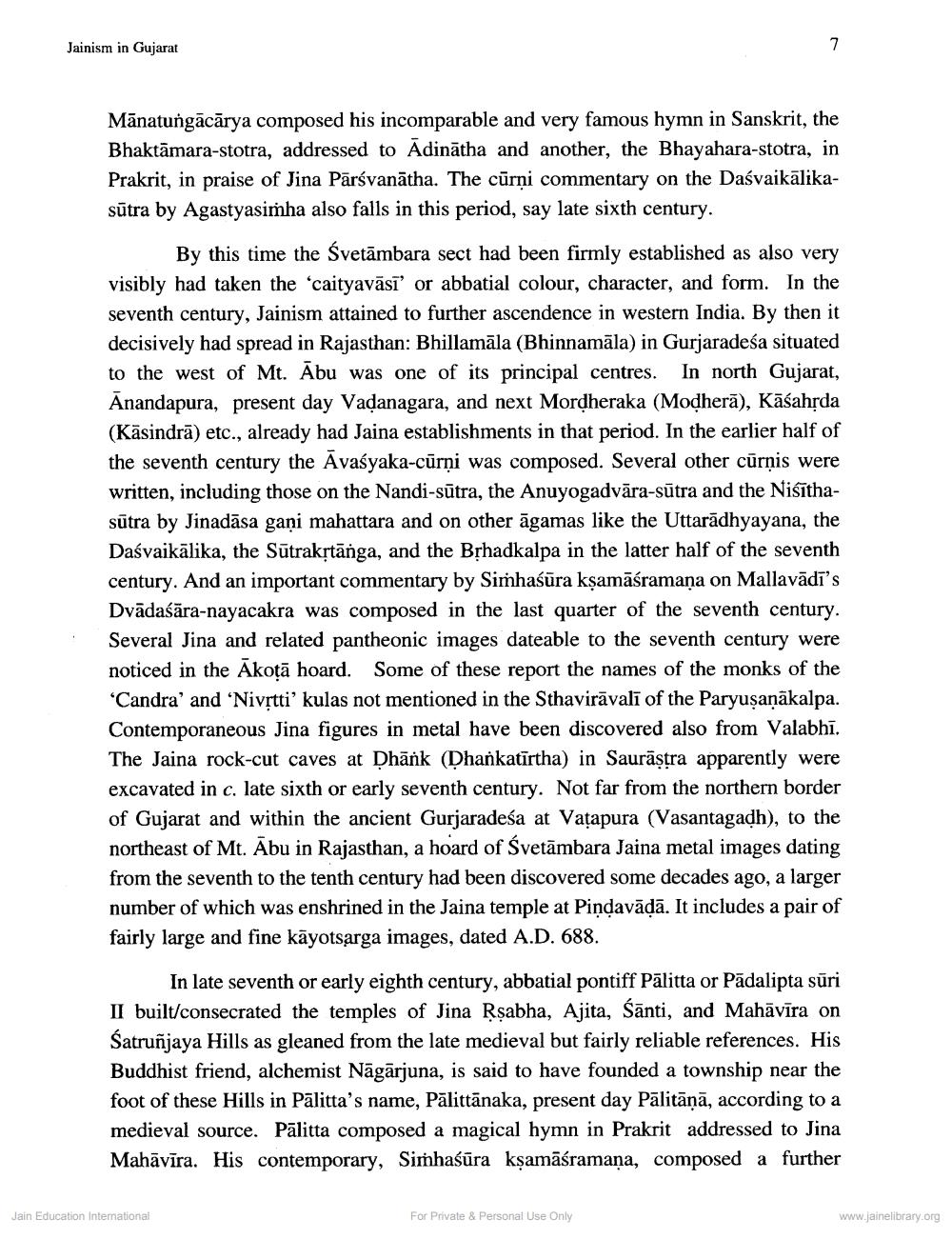________________
Jainism in Gujarat
Mānatungācārya composed his incomparable and very famous hymn in Sanskrit, the Bhaktāmara-stotra, addressed to Adinātha and another, the Bhayahara-stotra, in Prakrit, in praise of Jina Pārsvanātha. The cūrņi commentary on the Daśvaikālikasūtra by Agastyasimha also falls in this period, say late sixth century.
By this time the Svetāmbara sect had been firmly established as also very visibly had taken the 'caityavāsī' or abbatial colour, character, and form. In the seventh century, Jainism attained to further ascendence in western India. By then it decisively had spread in Rajasthan: Bhillamāla (Bhinnamāla) in Gurjaradeśa situated to the west of Mt. Abu was one of its principal centres. In north Gujarat, Anandapura, present day Vadanagara, and next Mordheraka (Modherā), Kāśahrda (Käsindrā) etc., already had Jaina establishments in that period. In the earlier half of the seventh century the Avaśyaka-cūrņi was composed. Several other cūrņis were written, including those on the Nandi-sūtra, the Anuyogadvāra-sūtra and the Niśīthasūtra by Jinadāsa gani mahattara and on other āgamas like the Uttarādhyayana, the Daśvaikālika, the Sūtrakstānga, and the Brhadkalpa in the latter half of the seventh century. And an important commentary by Simhaśūra kşamāśramana on Mallavādī's Dvādaśāra-nayacakra was composed in the last quarter of the seventh century. Several Jina and related pantheonic images dateable to the seventh century were noticed in the Ākotā hoard. Some of these report the names of the monks of the 'Candra' and 'Nivrtti' kulas not mentioned in the Sthavirāvalī of the Paryusaņākalpa. Contemporaneous Jina figures in metal have been discovered also from Valabhī. The Jaina rock-cut caves at Dhānk (Dhankatīrtha) in Saurāstra apparently were excavated in c. late sixth or early seventh century. Not far from the northern border of Gujarat and within the ancient Gurjaradeśa at Vatapura (Vasantagadh), to the northeast of Mt. Ābu in Rajasthan, a hoard of Svetāmbara Jaina metal images dating from the seventh to the tenth century had been discovered some decades ago, a larger number of which was enshrined in the Jaina temple at Pindavādā. It includes a pair of fairly large and fine kāyotsarga images, dated A.D. 688.
In late seventh or early eighth century, abbatial pontiff Pālitta or Padalipta sūri II built/consecrated the temples of Jina Rsabha, Ajita, Sānti, and Mahāvīra on Satruñjaya Hills as gleaned from the late medieval but fairly reliable references. His Buddhist friend, alchemist Nāgārjuna, is said to have founded a township near the foot of these Hills in Pālitta's name, Pälittānaka, present day Pālitāņā, according to a medieval source. Pālitta composed a magical hymn in Prakrit addressed to Jina Mahāvīra. His contemporary, Simhaśūra kşamāśramana, composed a further
Jain Education International
For Private & Personal Use Only
www.jainelibrary.org




